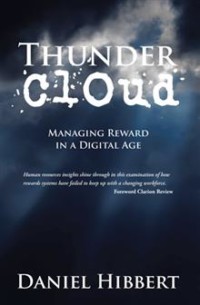Title: Thunder Cloud: Managing Reward in a Digital Age
Author: Daniel Hibbert
Publisher: AuthorHouse
ISBN: 978-1-52463-178-9
Pages: 116
Genre: Applied Psychology
Reviewed by: Allison Walker
Buy Book on AmazonPacific Book Review
Businesses are like thunderclouds, they are complex, unpredictable and irrational. Too many businesspeople treat their businesses like clocks, argues author Daniel Hibbert. A clock is simple and predictable, he continues. Do not make the mistake of thinking a thundercloud is a clock. In his book, “Thunder Cloud,” Hibbert dismisses the traditional process of data and measurements to determine employee behavior and the value of rewards. Human behavior is the study of psychology, not math, Hibbert writes. Treating people like mathematical equations is an easy way to make decisions, as well as a lazy one.
Instead, Hibbert employers should create reward systems based on the individual needs of their business and employees. While a black and white reward ladder might have been effective when jobs were simpler, more complex rewards systems behoove the more complex job responsibilities of this digital age. The wealth of information, and numerical data, easily accessible to employers through their computers makes a numbers-based reward system more tempting than ever. But the increased complexity, skill and experience required of modern jobs necessitates the opposite: a psychological-based reward system that takes into account the many roles a single employee is responsible for.
“Thunder Cloud” is designed in very much a textbook-style: Certain words are bolded, and accompanied by definitions in the back of the book. Charts and diagrams illustrate the ideas being communicated. A list of referenced material is included at the end. The textbook suits the information very well, and makes what could become a dry manuscript into a book that is very easy to learn from.
While predominantly addressing employers, “Thunder Cloud” is a book employees can gain enlightenment as well. Tools for employers to determine how much a position is worth, and what should be paid to it, answer many questions potential employees might bring to a job offer. The psychological reasons Hibbert gives as to why some employees work harder than others, become an explanation of why some jobs motivate and inspire while others don’t. Hibbert takes time to address everything from large corporations to a privately owned small business, from the lowliest employee to the highest CEO, even taking time to compare the needs of an individual employee to the need for team continuity.
From an employee perspective, it’s interesting to learn the psychological reasons behind why some pay raises thrill us, and why others may be a disappointment. “Thunder Cloud” is a self-conscious and objective look into the human mind. For employers, “Thunder Cloud” offers methods to develop a unique incentive program, but conspicuously does not supply any concrete solution. In fact, in the beginning of his book, Hibbert states he purposefully avoids offering any reward solutions. Businesses are each too individualistic to have the same solution. Instead, Hibbert explains the many types of rewards available to employers, when they do or don’t work, how to implement them, and how and why people typically respond to them.
The book concludes with a neat list of “rules,” especially helpful after the wealth of information offered. By the time readers turn the last pages of “Thunder Cloud” and close the cover, they will have a much greater understanding of why some jobs excite productivity, why some are disheartening, and how to turn a dull and confusing reward system into one that impresses and excites employees.



Follow Us